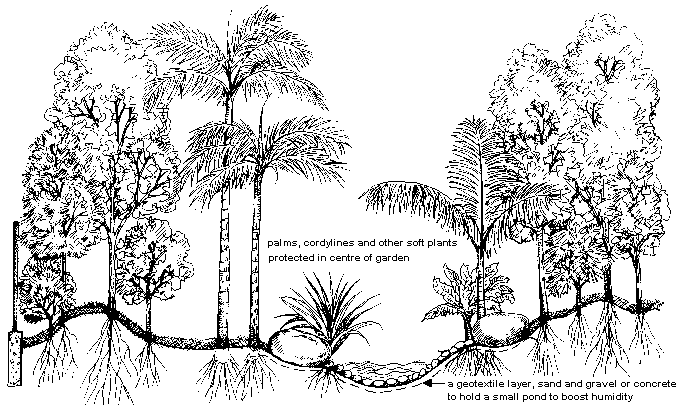Both semi alpine and true alpine habitats of north eastern Victoria and south eastern New South Wales are covered by the book. This includes Namdagi, Kosciuskco Victorian Alpine and Mt Buffalo National Parks.. The book confines itself to the flowering plants (ie ferns, fungi etc are excluded) and also it also excludes trees, grasses and sedges. The exclusion of trees is my only quibble. The authors state the relatively few eucalypts in the region are "...dealt with elsewhere..." and their identification "...does not rely strongly on flowers". Fair enough. But inclusion of the eucs would have been nice! Apart from the species descriptions, the book also includes some broad comments on alpine vegetation and habitats and provides clear diagrams and explanations of basic flower structure. Particularly useful are the guides to pronunciation of each plant name... as in "cal-IST-e-mon pit-ee-OY-deez" (Callistemon pityoides). The authors have been involved with the local environment movement in the ACT for many years and have collaborated on 6 previous publications about the flora and fauna of the region. Since 1984 they have run the successful Environment Tours programme which has introduced hundreds of people to the wonder of the Australian bush. "Wildflowers of the Snow Country" will be an indispensable aid to anyone interested in alpine flora. It might just be enough to make me finally visit the high country this summer.  Australia’s Most Threatened Ecosystems - the Southern Lowland Native Grasslands
|
| "......of the grassland sites in Western Victoria recorded by John Sturve in 1986, 44% had been destroyed, severely degraded or earmarked for destruction by 1992" |
The undoubted horticultural and eco-tourism potential of native grasslands are discussed, but despite these and numerous other attributes most native grassland remnants continue to be destroyed. "For example, of the grassland sites in Western Victoria recorded by John Sturve in 1986, 44% had been destroyed, severely degraded or earmarked for destruction by 1992". The next chapter goes into the ecology of lowland grassland, its pre-European distribution, the causes of ‘treelessness’ and the values and timing of fire as a management tool.
Further chapters deal with and discuss all the rare and endangered plants, reasons for their decline, the threat of weeds, and a thorough description of the major grassland communities.
The final chapter "Saving the Grasslands" discusses the reasons why grasslands are still disappearing, best management regimes, and what actions need to be taken to ensure the survival of all grassland communities. This includes advice for Governments as well as individuals and community organisations, so that we can all contribute to the conservation of this ecosystem.
There is an excellent appendix of further reading for those wishing to delve further into this wonderful plant community. With numerous line drawings and over 20 colour plates, this book should be compulsory reading for all those interested in this, our most threatened ecosystem. I found this little book to be an excellent and concise guide to the natural and man-made history of grasslands and their management in SE Australia. After reading it I can see that every small remnant grassland is of value and worth preserving.
From the June 1998 issue of the newsletter of the Australian Plants Society (Victoria).

Creating an Australian Rainforest Garden
Ralph Bailey and Julie Lake
Published by Lothian, Port Melbourne, Victoria, 3207, 1994
Softcover, 64 pages, $AUS12.95
Reviewed by Brian Walters
Interest in Australian rainforest plants has increased greatly over the past few years...witness the burgeoning membership of the Rainforest Study Group. However, the gardening public is still largely ignorant of the wealth of beautiful plant species hidden away in Australian rainforests. This book is aimed at a general audience but there is sufficient detail and information to satisfy the needs of even the most expert grower of Australian plants.
The book contains a wealth of diagrams, tables and photographs (some in brilliant colour) and includes sections on planning, plant selection, maintenance, weed control, pests and diseases and basic propagation. Other sections cover planting in specific situations (eg. coastal planting, small gardens/courtyards, containers and growing rainforest plants in inland areas). All sections include listings of suitable species for the particular application.

A very useful chapter covers the selection of plants based on desirable characteristics. This includes plants with spectacular flowers, variegated foliage, edible fruit, colourful new growth and decorative fruit (including a list of no less than 30! different "Lily-Pillys"). Plants which are desirable for their fragrant flowers or foliage are also covered although, as the authors note, sometimes fragrance is a personal thing...how many would like to grow Mallotus claoxyloides, said to smell like possums? (Possum's what, I ask you!)
Another chapter is devoted to the enjoyment of the garden, something often overlooked. Here the authors discuss lighting, creating vantage points, garden furniture and attracting wildlife.
Overall the book mentions several hundred rainforest species and 50 are described in detail. A list of suppliers of rainforest plants is included; as might be expected, most of these are in northern NSW and Queensland.
This is a very well presented book at a reasonable price and is one which deserves to succeed. The authors are well qualified. Ralph Bailey is an architect/landscape planner and is the designer of the Gondwana Rainforest Sanctuary at Southbank, Brisbane. Julie Lake is a horticultural writer and Queensland correspondent for "Australian Horticulture" journal. Both are members of SGAP.

[Front Page] [Features] [Departments] [SGAP Home Page] [Subscribe]
Australian Plants online - December 1998
The Society for Growing Australian Plants

